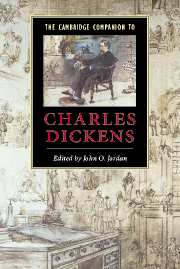Book contents
- Frontmatter
- Preface
- 1 The life and times of Charles Dickens
- 2 From Sketches to Nickleby
- 3 The middle novels
- 4 Moments of decision in Bleak House
- 5 Novels of the 1850s
- 6 The late novels
- 7 Fictions of childhood
- 8 Fictions of the city
- 9 Gender, family, and domestic ideology
- 10 Dickens and language
- 11 Dickens and the form of the novel
- 12 Dickens and illustration
- 13 Dickens and theatre
- 14 Dickens and film
- Selected bibliography
- Index
- Series list
8 - Fictions of the city
Published online by Cambridge University Press: 28 May 2006
- Frontmatter
- Preface
- 1 The life and times of Charles Dickens
- 2 From Sketches to Nickleby
- 3 The middle novels
- 4 Moments of decision in Bleak House
- 5 Novels of the 1850s
- 6 The late novels
- 7 Fictions of childhood
- 8 Fictions of the city
- 9 Gender, family, and domestic ideology
- 10 Dickens and language
- 11 Dickens and the form of the novel
- 12 Dickens and illustration
- 13 Dickens and theatre
- 14 Dickens and film
- Selected bibliography
- Index
- Series list
Summary
Realism in Dickens’s time was magical, for the city was a fairy-tale come to life, grim, exhilarating, and transformative. To describe this urban world was to create a new Bible, encompassing heaven and earth, and all that lies between, the keynote struck at the beginning of Bleak House:
London. Michaelmas term lately over, and the Lord Chancellor sitting in Lincoln’s Inn Hall. Implacable November weather. As much mud in the streets, as if the waters had but newly retired from the face of the earth, and it would not be wonderful to meet a Megalosaurus, forty feet long or so, waddling like an elephantine lizard up Holborn Hill.
(BH 1)Personal experience fed the literary work: when Dickens was born on 7 February 1812, London was a city of horse-drawn carts and carriages, entered through city gates like Charing Gate, Newgate, with its formidable prison, and Kennington Toll Gate. When Dickens died fifty-eight years later in 1870, the gates and city wall had been pulled down and built on, and London turned into a sprawling monumental city, transformed by the industrial revolution, especially the railroad and entrepreneurial capitalism as well as the British imperial venture, into the first world-city.
- Type
- Chapter
- Information
- The Cambridge Companion to Charles Dickens , pp. 106 - 119Publisher: Cambridge University PressPrint publication year: 2001
- 1
- Cited by

